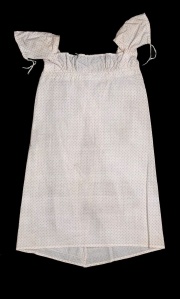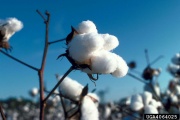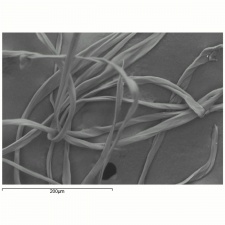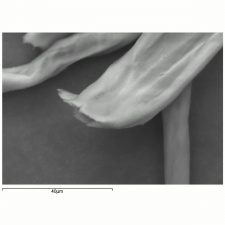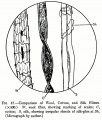Cotton
Description
A strong, natural vegetable fiber obtained from the exterior of the seeds of various species of Gossypium native to India, the Sudan, and Ethiopia. Cotton is a major textile fiber and an important source of Cellulose. It contains 88-96% pure Alpha cellulose; the remainder is Protein, Pectin, Sugar, Oil, and Wax. Cotton cloth was made as early as 5000 BCE in India. By 3000 BCE, cotton fabrics were being woven in Egypt, China, and Peru. Cultivation of cotton became wide spread in Europe in the Middle Ages. Today, most cotton is grown in the United States, China, India, Pakistan, Brazil, and Turkey. Microscopically, cotton fibers look like flattened twisted tubes. They have good luster and dye well with basic, direct, vat, and reactive dyes producing lightfast and washfast colors. Cotton is used for making fabrics, cordage, padding, plastics, and rag paper.
See also Mercerized cotton.
Synonyms and Related Terms
white gold; qutun; kutun; coton (Fr.); bomuld (Dan.); Baumwollpflanze (Deut.); Baumwolle (Deut.); algodón (Esp.); cotone (It.); katoen (tje), katoenweefsel,katoenen stof; watje; katoenplant (genus Gossypium) katoengewas;katoen (draad/garen/stof/vezel); pluis (Ned); bomull (Nor., Sven.); algodão (Port.);
Other Properties
Resistant to alkalis and most organic solvents. Degraded by strong acids and cuprammonium hydroxide.
Fiber length = 1.6 - 6 cm. Moisture regain 7.0-8.5 % Elongation = 5-10%
Cotton burns with a steady flame and smells like burning leaves. The flame can be easily extinguished by blowing and the ash is easily crumbled.
| Melting Point | 148 (dec) |
|---|---|
| Density | 1.54-1.56 |
Hazards and Safety
Discolors and eventually degrades in sunlight. Combustible. Susceptible to mildew, bacteria and silverfish. Resistant to moths and beetles. Toxic by inhalation of dust.
Additional Information
G.Cook, Handbook of Textile Fibres:I. Natural Fibres, 5th edition, Merrow Publishing Co., Durham, England, 1984.
Comparisons
Additional Images
Authority
- Encyclopedia Britannica, http://www.britannica.com Comment: "Cotton." Encyclopædia Britannica. 9 Mar. 2004 .
- Hoechst Celanese Corporation, Dictionary of Fiber & Textile Technology (older version called Man-made Fiber and Textile Dictionary, 1965), Hoechst Celanese Corporation, Charlotte NC, 1990
- The Dictionary of Paper, American Paper Institute, New York, Fourth Edition, 1980
- J.Gordon Cook, Handbook of Textile Fibres:I Natural Fibres, Merrow Publishing Co. , Durham, England, 1984
- The Dictionary of Art, Grove's Dictionaries Inc., New York, 1996 Comment: 'Cotton'
- Reed Kay, The Painter's Guide To Studio Methods and Materials, Prentice-Hall, Inc., Englewood Cliffs, NJ, 1983
- Hermann Kuhn, Conservation and Restoration of Works of Art and Antiquities, Butterworths, London, 1986
- Rosalie Rosso King, Textile Identification, Conservation, and Preservation, Noyes Publications, Park Ridge, NJ, 1985
- Michael McCann, Artist Beware, Watson-Guptill Publications, New York City, 1979
- Matt Roberts, Don Etherington, Bookbinding and the Conservation of Books: a Dictionary of Descriptive Terminology, U.S. Government Printing Office, Washington DC, 1982
- Marjory L. Joseph, Introductory Textile Science, Holt, Rinehart and Winston, Fort Worth, TX, 1986
- A.Lucas, J.R.Harris, Ancient Egyptian Materials and Industries, Edward Arnold Publishers Ltd., London, 4th edition, 1962
- G.S.Brady, Materials Handbook, McGraw-Hill Book Co., New York, 1971 Comment: p. 245
- Van Nostrand's Scientific Encyclopedia, Douglas M. Considine (ed.), Van Nostrand Reinhold, New York, 1976
- Random House, Webster's Encyclopedic Unabridged Dictionary of the English Language, Grammercy Book, New York, 1997
- The American Heritage Dictionary or Encarta, via Microsoft Bookshelf 98, Microsoft Corp., 1998
- Art and Architecture Thesaurus Online, http://www.getty.edu/research/tools/vocabulary/aat/, J. Paul Getty Trust, Los Angeles, 2000
- Dictionary of Building Preservation, Ward Bucher, ed., John Wiley & Sons, Inc., New York City, 1996 Comment: comment
